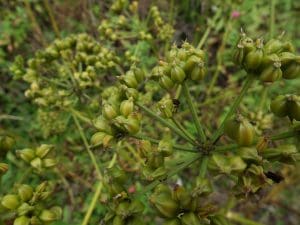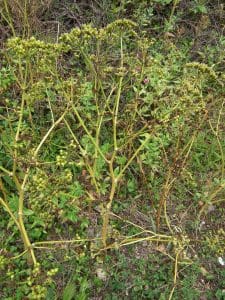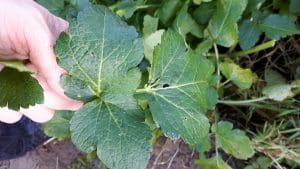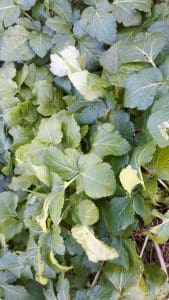Alexanders / Spring / Summer / Autumn / Winter / Edible
Welcome to our guide on Alexanders (Smyrnium olusatrum), a fascinating and versatile wild edible that deserves a place in every forager’s repertoire. Often overlooked in favour of more well-known wild plants, Alexanders is a highly nutritious and flavoursome addition to your foraged feasts. This robust, aromatic plant can be easily identified by its vibrant green, glossy leaves, yellowish-green flowers, and hollow stems.
Native to the Mediterranean region but widely naturalised in other parts of the world, Alexanders is commonly found along coastal areas, hedgerows, and waste ground. In this guide, we will delve into the identification and sustainable foraging practices for this remarkable plant, ensuring that you can confidently recognise and harvest Alexanders while minimising any impact on its natural habitats. We’ll also share tips on how to prepare and incorporate this versatile ingredient into your dishes, allowing you to experience the full depth of its unique flavors and health benefits. So, join us as we explore the wonderful world of Alexanders and unlock the secrets of this hidden gem in the realm of wild edibles.
Common Names
Alexanders, horse parsley, alisanders and smyrnium.
Botanical Name
Smyrnium Olusatrum
Scientific Classification:
Kingdom – Plantae
Order –Apiales
Family – Apiaceae
Physical Characteristics for Alexanders
Alexanders is a stout biennial, typically growing from 1-2 metres. It has a solid and easily peeled green, green-yellow stem, becoming hollow with age.
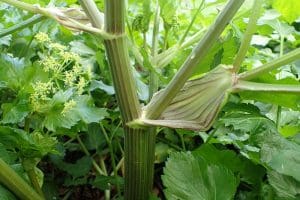
Leaves
The leaves are glossy, bluntly toothed with broad segments. The leaves have a distinctly purple veined sheath at their base, and grow in groups of three.
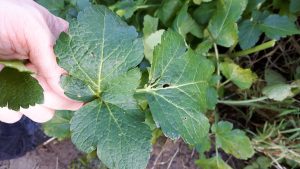
Flowers
On top of the stem sits an umbelifer or flowering dome of yellow-petalled flowers, making it easier to distinguish from other plants in this family as their flowers are typically white.
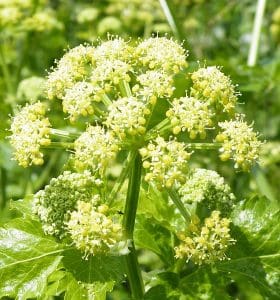
Seeds
The highly aromatic seeds grow from 6-9mm long, are ridged and at maturity turn from green to jet black.
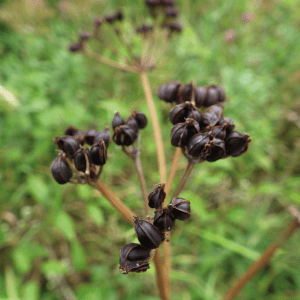
Root
A single taproot, looking a bit like a parsnip with a black skin
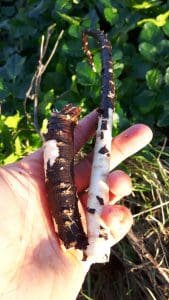
Habitat
Throughout the British Isles favouring the south and coastal areas, although it can be found inland, especially in places of former Roman occupation. Found throughout Southern Europe, Southern Asia, Northern Africa, and North America.
Grasslands, waysides, open woodland, coastal areas and scrub land, growing almost anywhere that there’s a disturbance of nutrient rich ground.
Known Hazards:
Non Known
Could be confused with:
Hemlock water dropwort (another member of the carrot family). This can be deadly poisonous. Among the many differences the key ones are that the leaves of Hemlock water dropwort are more finely lobed. Hemlock water dropwort typically grows in damper locations than Alexanders, on river banks or above an underground water source. When in seed it’s easily distinguishable as Alexander seeds are jet black and Hemlock water dropwort seeds are not. Hemlock water dropwort has clusters of yam-like tuberous roots whereas Alexanders has a single main tap root which is obviously jet black/dark brown.
Edible Uses
Root: Collected autumn, winter and spring (very pungent flavour). Excellent grated in coleslaw or tossed in salads, roasted like parsnips or deep fried as crisps, syrup, wine/beer.
Stem: Fresh young winter and spring leaf stems (including blanched underground white section) are excellent steamed, tossed in butter and seasoned with sea salt, freshly ground pepper and lemon juice. The flowering stem (before flowering) is excellent candied, pickled, in tempura batter, peeled and eaten raw, syrup, wine/beer.
Leaves: in salads, as a herb, as a vegetable, in soups, candied, syrup, wine/beer.
Immature flower clusters: Pickled, candied, raw in salads, syrup, wine/beer.
Mature Flowers: Tempura, cordial, syrup, wine/beer.
Seeds (full grown but green): Pickled, candied, syrup, wine/beer.
Seed (mature and black): Spice, seasoned flour, syrup, wine/beer.
Use a knife to cut away from young tender leaf stems, cutting below the surface of the soil, up to 3 inches, you’re looking for the white parts of the stem which is most tender.
Specifically noted the Angle Shades moth caterpillars which are almost the same colour as the foliage (if collected in March) so requires good washing to make sure they’re removed.
If you find the flavour too strong on trying this plant raw as an herb for the first time, cooking really moderates and loosens the pungency of flavour, making it more palatable.
Notes on Herbal uses
Although this plant is rarely used within common herbalism, the juice was once used to clean out cuts and the whole plant, as a bitter, eaten to aid digestion.
Extra notes from the Foragers
The name Alexander is a reference to Alexander The Great and to the city Alexandria that he founded in Egypt where a variety of these plants can be commonly found.
This plant is often found around old religious buildings as the plant was highly revered as a religious herb.
Horses enjoy this plant as do cows, sheep and other grazing mammals. The Romans actually brought this plant to England with them to use as feed for their horses through the winter. Over 137 insects and bees have been recorded as being attracted to this plant, as it’s one of the earliest spring flowering plants. Watch out for the vibrant green but camouflaged caterpillars of the Angle Shades moth that can be hard to spot.
Smyrnuim indicates the plants distinct myrrh-like aromatics. While Olusatrum comes from Olus meaning garden herb and Atrum from the Latin ater, atrum, adjective atro, meaning black or dark (in this case a reference to the mature black seeds).




